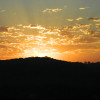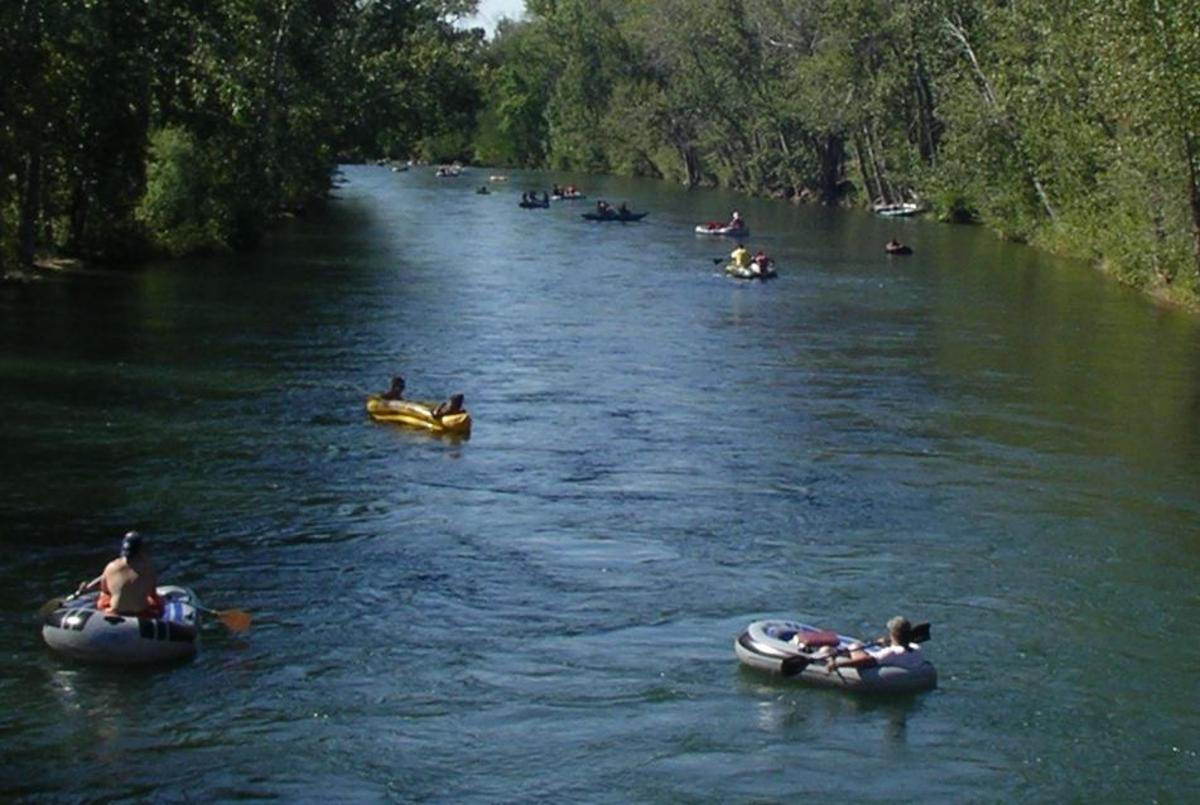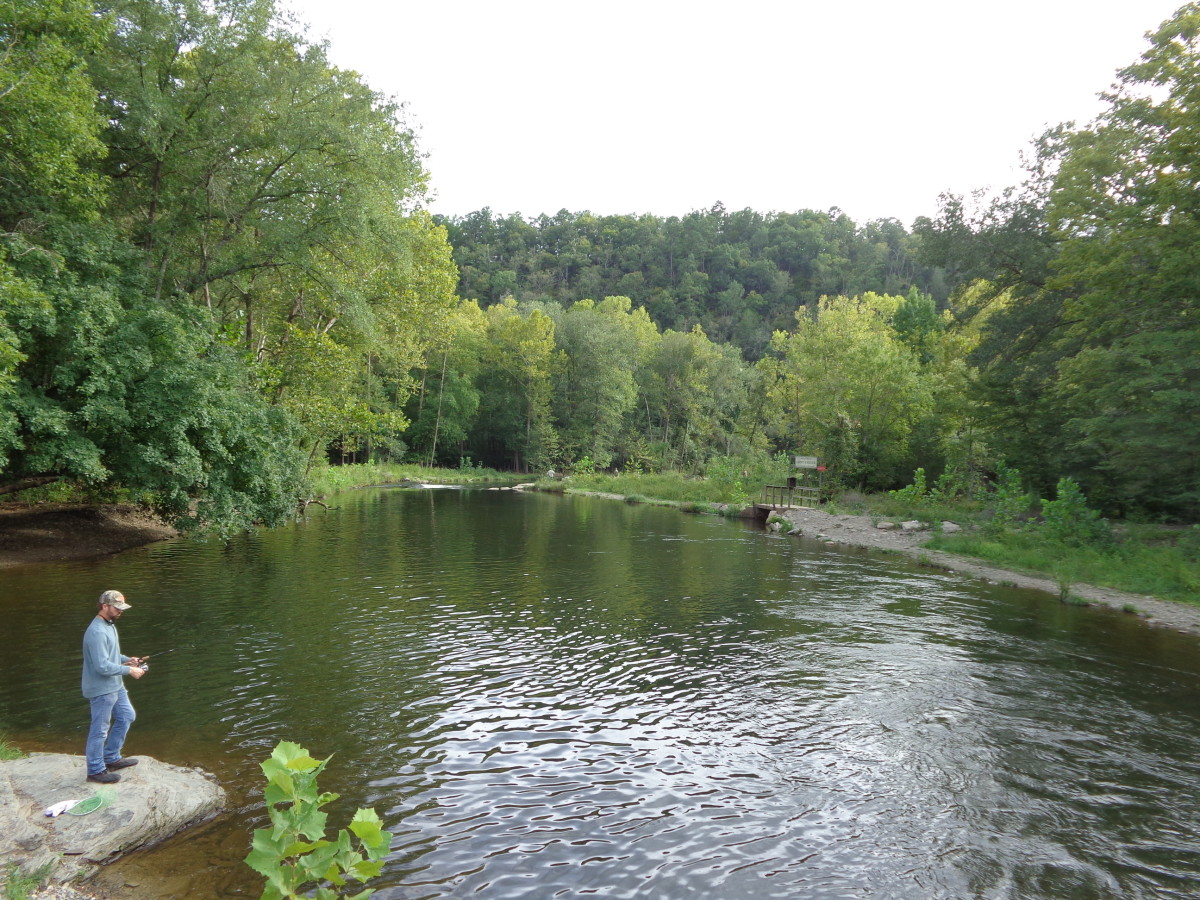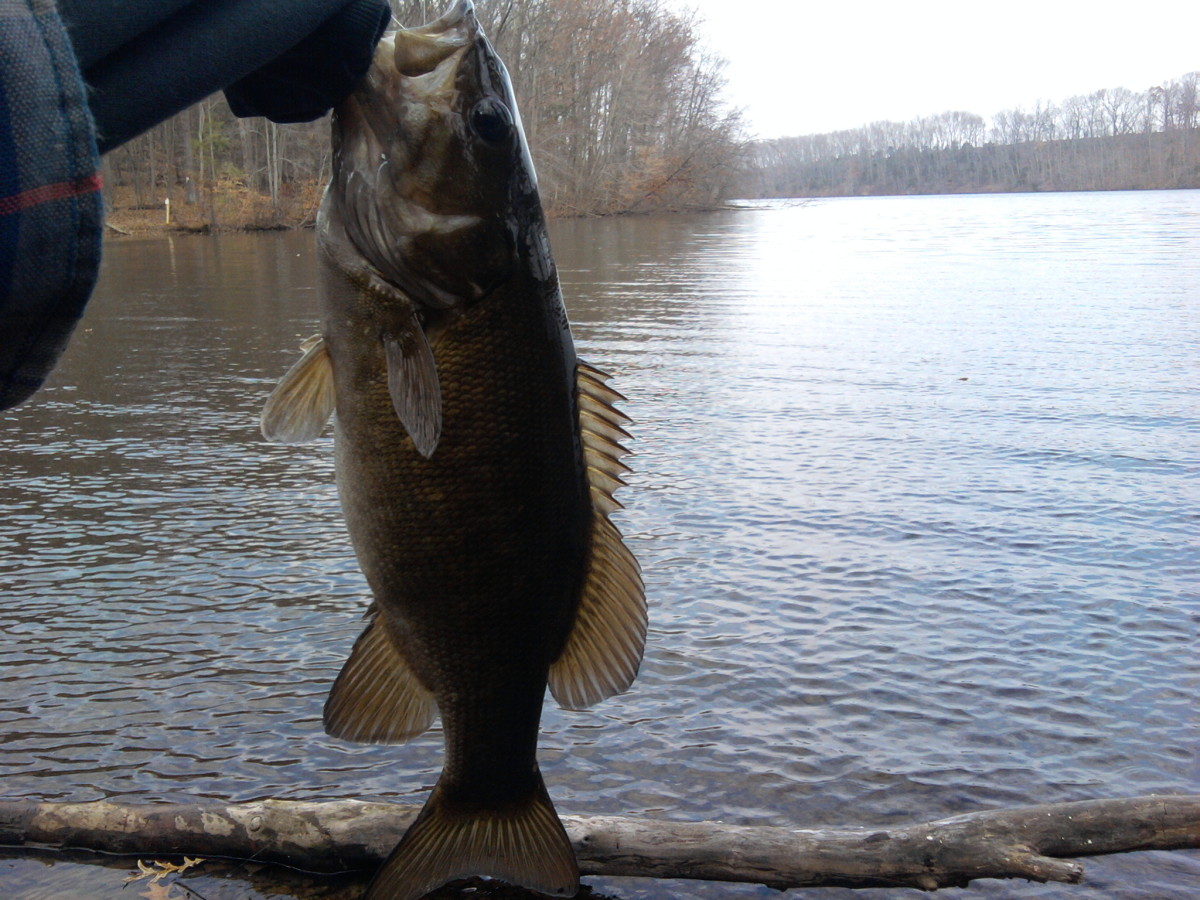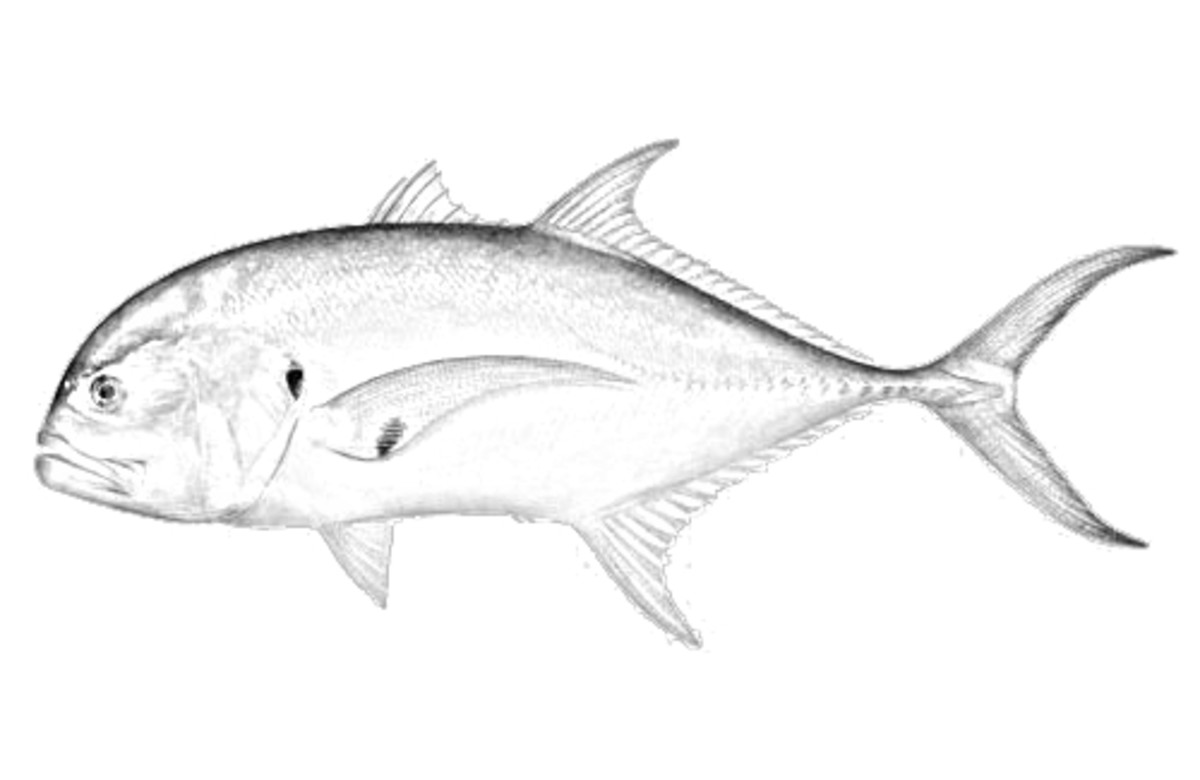The White River - Finding Trout in Missouri and Arkansas
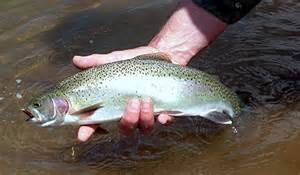
Mid August, 1977
"Why don't you go fishing on the river?" my father asked me. We had just moved down to Flippin, Arkansas (population 1,036. SAAA-LLLUUUTTEEE!!) on August 16th which everyone knows was the day Elvis died. He had been offered, and accepted, to become the newest Plant Manager for LaBarge, Electronics, with the added luxury of having a new facility built. I worked for LaBarge as well, but because there was no facility yet, I had lots of free time. 17 years old, in a new state, new town, and nothing to do with those people I didn't know. So, go fishing.
I went down to the river, crossing over at Cotter. I literally stopped on the bridge (no traffic, you see) and stared down at the riverbed. I could not see the water! Then, sunlight glinted off of an invisible surface and I realized this was the clearest water I had ever seen. I drove on down, parked beside a railroad bridge over the river, gathered my gear and set out. I found some trout in a hole near the bridge and began fishing. I was a novice to the nth degree so corn was the bait of choice. At least, that is what I had been told.
Those first trout were difficult. Raised on tougher mouthed fish such as Largemouth Bass, White Bass, Northern Pike, Walleye and the occasional Crappie, I hard a hard time keeping the hook in the trout's mouth. Time and again I set the hook too firmly and pulled it out of the trout's soft mouth. Eventually I learned to sweep the rod rather than yank it, and I had my first trout.
I caught a couple before wading across to a small island and continued upstream, casting along both sides of the island. I came to the end of the island and crossed back across to the bank, continuing to fish. Finding a small feeder creek, I made my way upstream until I could go no farther. I had caught four, and felt pretty good about it. They were all in the 15" range, nice sized trout.
Working back downstream, I came to where I had crossed to the island. Wading out, I found the current stronger, the water deeper than only an hour ago. Confused, I backed out and tried another place. Same thing. I finally made my way back downstream along the river through some mighty thickets full of briars and brambles, dragging my stringer full of trout before arriving at my car.
This was my first introduction to the White River, Rainbow Trout, and a river controlled by releasing water from a dam upstream.
Welcome to Arkansas.
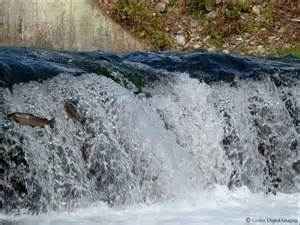
Trout Waters in Missouri and Arkansas
Trout are not native to the central portion of the United States, so all found here are brought in. In Missouri and Arkansas there are several locations which spawn and raise trout with the intent of stocking them into waterways across the area. In Missouri, the White River flows through Table Rock Lake and exits into Lake Taneycomo. The cold waters flowing from beneath the dam destroyed one fishery but created another. Gone were the days of Jim Owens and float trips catching largemouth bass and crappie, and born were the days of world class trout fisheries in the tailraces below the dams along the river.
Taneycomo flows over Powersite Dam, created in 1931 and into Bull Shoals Lake. The North Fork of the White River flows through Norfork Lake and joins its big sister before continuing on. The cold, highly oxygenated waters present virtually perfect habitats for trout and they grow large.
In Missouri, there are several Trout Parks featuring put and take fishing for a fee. There are also a few streams capable of supporting a population of trout in the state. One of these is Capps Creek in southwest portion of the state and has a decent population for those who are willing to work a bit.
Rainbow Trout also were found in a very unusual location some years back. The city of Joplin was doing some construction on the falls outside of town on Shoal Creek. This is a warm water area with temperatures soaring into the 80's during summer months. Yet when workers diverted the water flowing over the dam and Grand Falls they found trout living in potholes between the dam falls and the natural Grand Falls with some exceeding 6 pounds. No one could say where they came from or how they came to be in the step area between the falls, but they were doing nicely there, feasting on insects and small baitfish.
Orlando Wilson and Forrest L. Wood about 1985
Hopefully you took the time to watch the video above, featuring Orlando Wilson and Forrest L. Wood on the White River below Bull Shoals Dam. I had the pleasure of meeting, working for, playing ball for, and bowling against Forrest in my time living in Flippin. As the designer and builder, then owner of Ranger Boats, Forrest made literally millions manufacturing bass boats. But before he had made his millions, he was a humble fishing guide on the river. Watch at the ease with which he maneuvers the boat while fishing. This is far harder than he makes it look!
Forrest is by far the wealthiest man I have ever known but to speak with him you would never know it. Several times I was invited out to his house to enjoy some pool and cards in the game room on the third floor of his massive house. But truly, he was more at home either in a boat or a saddle, fishing or working his cattle than he was in an office. His family is just as nice as he is and again, you would never know his true financial worth; his personality is that of a humble, kind, generous man.
Later in life he sold the company and then sponsored a Bass Fishing tournament series that still bears his name. The FLW tour.
1977 to 1981
For four years, I fished the White River whenever I could, as well as the surrounding streams like Blue John, Clabber Creek, and the world famous Crooked Creek. Smallmouth Bass dominated those other streams but Trout were the species that held sway over the White. From just below Bull Shoals Lake to near Buffalo River, I fished this river catching Rainbows every time I went.
For the most part, I waded, without the benefit of waders. That 45 to 50 degree water turned my legs and feet blue but I was young, hardheaded, and driven. Once in a while we rented a river boat and floated. When we did this we would routinely float over huge trout, 15 to 20 pounds and up. We would drift along, casting and move over a log in the water; but it wasn't a log: it would be a massive Rainbow or Brown trout, holding in the crystal clear water waiting, just waiting.
We would cast crankbaits better suited for bass and walleye such as Wiggle Warts and Rapala's and catch nice fish, up to 6 pounds or so. We never hooked into one of those monsters but it wasn't for the lack of trying.
This life came to an end in June 1981 when we moved back to Missouri. But my trout fishing did not end; it simply adapted.
Recipe for Rainbow Trout
Trout is considered a delicacy by many and my family is no exception. Here is one of our favorite methods for cooking these tasty fish.
We begin with a decent sized trout, perhaps 12 to 15 inches weighing 3/4 to 1 1/4 pounds or so. Clean the trout (if it hasn't been done yet) by placing a sharp filet knife into the vent on the belly, moving it forward to just behind the lower jaw. We normally make another cut behind the head downward through the body. Grasp the head and pull downward. This should remove most of the entrails at the same time. Turn the body upside down beneath cold running water and use your thumb to brush along the cavity against the backbone. Continue this until the cavity is clean.
Preheat the oven to 350 degrees F. Take a piece of aluminum foil about 18" long and spray with the cooking oil of your choice. Coat the trout with oil, then dust with use a lemon pepper spice. Slice a lemon into thin sections and place one or two inside the cavity then add sliced almonds along the outside. Roll the foil up enclosing the trout securely and place onto a cookie sheet. Slide the tray into the oven and bake for 15 to 20 minutes.
Remove from the oven and enjoy. Some like a nice white wine to enhance the flavor. Trout meat flakes off easily Use a fork to gently move the meat from the tiny ribs trout have and enjoy. For children, we suggest removing the meat before serving.
Something unique when eating these tasty treats is that once you have finished the top portion you can gently grasp the tail and pull up, thereby removing the backbone and ribs from the remaining fillet.
You can also use this method when camping. Simply dig a hole in the coals of your campfire and bury the foil wrapped trout there, covering them with live coals. 15 minutes later, voila'!
Classic documentary on the life of a trout.
Missouri Early 1980s
Moving back to Southwest Missouri made me say goodbye to the fine stream fishing I had found in Arkansas. And it took a while but I eventually found how to fish for trout again. Roaring River, near Cassville, featured a put and take fishery with a hatchery on site to fulfill the demands of those pursuing these piscatorial wonders. But it wasn't the same.
First, 99% of these fish are raised solely for catching; in other words they are stupid. Each day's fishing is carefully tabulated, and those fish caught are immediately replaced by ones from the hatchery. Some of these will survive a day or so, and gradually improve their survival instincts but most wind up in somebody's frying pan that evening.
The regulations make it a bit tougher on the fisherman by denying the use of natural baits; rather only single hook lures are allowed. Fly fishing is popular here with the upper portion dedicated to flies only. There is a center section set for catch and release only where it is legal to wade, then the lower section where the regulations are a bit more relaxed.
The primary trout here is Rainbow, but there are a few Brown Trout here, hidden gems amongst the other trout. To date, I have but one of these beautiful fish to my credit but it holds a high mark in my treasury of fishing memories. It was on a fly rod, on a hand tied crawdad pattern I tied so this makes it even more special in my eyes.
From there, I moved on to Taneycomo near Branson a time or two, but primarily I have fished in Roaring River over the years. Someday I look forward to expanding my horizons to Western rivers like the Yellowstone and Bighorn. Maybe, maybe...
But for now, let's take a look at the trout that live in and around this area and their characteristics and methods of catching them.
- Missouri Trout Fishing - Rainbow & Brown Trout Fishing - Fly Fishing in MO
All about fishing for Trout in Missouri - All about fly fishing for rainbow and brown trout - Missouri Fly fishing for trout - Picture of each trout - Trout fishing tips on lures, baits and flies - MO Trout fishing at it's best!
Trout Records in Missouri and Arkansas
Species
| Missouri Record
| Arkansas Record
|
|---|---|---|
Rainbow Trout
| 18 lb 1 oz
| 19 lb 1 oz
|
German Brown Trout
| 28 lb 12 oz
| 40 lb 4 oz
|
Cutthroat Trout
| N/A
| 9 lb 9 oz
|
Brook Trout
| N/A
| 5 lb 0 oz
|
Lake Trout
| N/A
| 11 lbs 5 oz
|
The Rainbow Trout
The Rainbow Trout may be the single most available and pursued member of the Trout family. They are catchable in a variety of methods from the complex Fly Fishing methods preferred by the purist on fishing outfits costing thousands of dollars to the common, bait fisherman casting worms (also known as "garden hackle") on a spin cast rod and reel purchased at a local grocery store. The most common size for these beautiful green backed, pink sided fish are from one to five pounds. The record for Missouri is 18 pounds 1 ounce caught in Roaring River August 14, 2004 by Jason Harper. Another, possibly larger Rainbow was caught in November of 2013 on fly rod and reel by Mark Clemishire while fishing Taneycomo. The brute measured 31" long and 23" around with an estimate weight in excess of 20 pounds. Mark chose to release this amazing fish rather than take a chance on killing it, but he did take some extraordinary pictures of it which can be viewed in the link below this section.
The Rainbow Trout prefer water in the 55 to 70 degree F range so this makes them more widespread in rivers and streams which become slightly warmer than the average water one thinks of as trout water.
The Arkansas record has stood for over 30 years now. Jim Miller landed a 19 pound 1 ounce Rainbow on March 14, 1981 while fishing on the White River. As I stated earlier, there are some massive trout in this fine tailrace fishery.
Trout can be caught on almost anything one chooses to toss into the water. Although many feel that to catch a trout on anything other than a hand tied dry fly, or possibly a wet fly or nymph is a sacrilege, many others are quite content to drown worms, cast crawdads and marshmallows on small hooks into the waters and are able to do very well. I have caught trout on many different baits and lures, and have also been skunked on other days.
One can wade fish (in comfortable neoprene waders for those of us who choose to not freeze our toes off), drift along in a boat, canoe or kayak, or simply pick a spot on a bank and cast away. The White River offers all three styles to any who desire to visit. The upper portion of Taneycomo has the most stringent regulations including what one may fish with and a slot limit in size. Only one fish per day may be in excess of 20" in the limit of four so as to maximize the opportunities for all to enjoy these wonderful fighters.
My preferred method, when alone and fishing simply for the pure enjoyment, is fly fishing while wading knee deep in the crystal clear waters. A hand tied fly created to tempt a solitary trout adds to the pleasure, and there is no other fish alive that jumps clear of the water higher or more often than a Rainbow Trout on a fly rod. They will spend more time out of the water than in it.
Generation tables for Table Rock Dam (TDC)
- Southwestern Power Administration
Southwestern Power Administration is an agency of the Department of Energy that markets hydroelectric power.
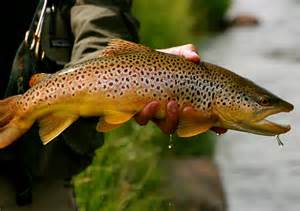
German Brown Trout
The German Brown Trout is one of the most beautiful in the Trout family in my eyes. The spotted markings along its sides, yellowish coloration underneath and brownish-green upper section makes this a truly wonderfully marked example of God's finest work.
The Brown Trout are less populous in number in the streams in the area, making them a trophy to those who pursue them. Typical methods again include fly fishing with a variety of dry, wet, and nymph patterns; live bait such as worms and baitfish; and lures imitating those natural baits. Both wade fishing and working from a boat will place the fisherman in position to catch their prize.
The Brown Trout prefer water in the 56 to 66 degree F range but will tolerate temps slightly above and below that.
Roaring River does have a few Browns, but Taneycomo has a larger population, and the area below Bull Shoals and Norfork in Arkansas is known the world over as being among the best waters in the world.
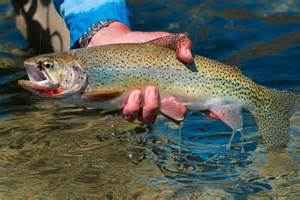
Cutthroat Trout
The Cutthroat Trout is a smaller fish than either the Brown or Rainbow, yet is a feisty member of the trout family. Most people typically think of the Cutthroat as a western fish, abounding in the Rocky Mountains yet few know they can not only do well but they can thrive in the Missouri Arkansas area. Though they do not grow as large as the Brown and Rainbow, don't count them out as being a lesser example of the family.
Identified as being an opportunistic feeder, they prefer insect and their various stages of life but will not turn their nose up at fish eggs, small baitfish and other items found in the waters and streams of the area. They are an active feeder frequently caught by fly fishing in the waters below the dams of the White River. The area below both Bull Shoals and Norfork Lakes in the White and North Fork of the White River in Arkansas feature the cold, clear highly oxygenated waters this species demand, in the 52 to 60 degree F range.
There is mention made of Cutthroat Trout in Taneycomo but I have yet to find confirmation regarding them. However, they are said to exist so when you do hit the waters keep a sharp eye out for a crimson slash beneath the chin of a trout which resembles a Rainbow Trout.
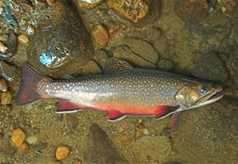
Brook Trout
The Brook Trout, another of the beautiful members of the family is actually a Char, as is the Lake Trout. Native to a few states along the Eastern Seaboard, these are among the earliest trout mentioned in the United States. They have made their way to a few select waterways west of their native range and are able to withstand water temperature ranging from 34 to 72 degrees F. They are again eaters of insects and their various stages such as pupae and larvae which lends them to be a favorite of the fly fisherman.
Not one of the larger trout, the world record stands at 14 lb. 8 oz. and is the longest current world record as it reaches back 100 years, to 1915.
Again, there is mention made of Brookies, as they are known living in Taneycomo but no records exist which confirm this. They are within the White River exiting Bull Shoals and Norfork in good populations for those who choose to challenge themselves and pursue this true trophy fish. Its colors are extraordinary with crisp white lining its fins, red or orange along the belly area, particularly during spawning seasons, and red dots surrounded by blue rings along its flanks mark this as one of the more colorful of the family.
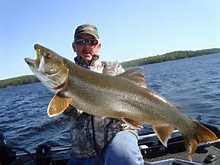
Lake Trout
The Lake Trout was probably the first trout I was introduced to way back in the late 1960s to early 1970s. Not because I lived where they flourish, nor because I went fishing for them as a child. No, because of The Sportsman's Friend, Harold Ensley. I would watch Harold and his family and friends every week as they set forth on another adventure in some wonderful location in America. I remember being amazed as he caught Lakers on a lure known as a Reaper often approaching 50 pounds. These fish were huge!
Growing larger than just about any other trout, the Lake Trout may not be as beautifully marked to some as the Rainbow or Brookie, but oh how they fight. Living primarily in the far north of Canada some have found their way south to Arkansas. While they may not live in the White River, they are just a bit further south in Greers Ferry Lake in Arkansas.
As they tend to be larger than their cousins (at least in the north) they seem to prefer small fish as their diet. They also live in deeper water, often in the very depths of lakes approaching 200 feet. Their preferred temperature is in the 50 to 57 degree F range so they will be found in a select portion of the waters they inhabit, making them possibly one of the most difficult trout to catch.
Personally, I prefer wading the shallow waters of a river, fly casting a home made fly of my own creation. I am not a fashionable caster as Norman Mclean described in A River Runs Through It, but neither am I a complete novice. I have landed Rainbows in the 6 to 7 pound range on a tiny tippit of 2 lb. test. As I stated earlier, if I am alone and simply set to enjoy myself, numbers do not matter. A few over the span of the day tempted into striking a hand tied creation of mine is quite satisfying, thank you. The rhythm one finds in fly fishing is a wonder unto itself.
The upper waters of Lake Tanycomo is about as river-like as a river can be, so wading during low water times is very similar to working a river in the mountains. A morning or evening hatch of a small insect will bring a trout to the surface every time. Watch for sipping along the surface of still waters and make your cast well above the area as trout tend to use the current to lift them to the surface, often floating several feet downstream before contacting the surface.
If the water is running higher in the area below the dams of the White River, you might have better luck in a boat drifting along and casting either a lure or a bait such as nightcrawlers or something similar. Either way, you are sure to have a wonderful day on the water, and who wouldn't want that?
